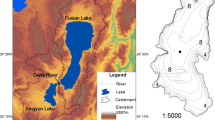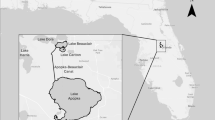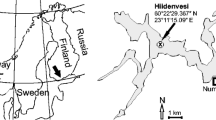Abstract
In order to assess how best to manage impacted lake systems, one needs to understand the trophic functioning of the lake system and the recent states through which the lake may have transitioned. Lakes in the middle and lower reaches of the Yangtze have been heavily impacted over recent decades. In order to understand recent changes in functional status, we examined sediment cores covering the last 120 years from two lakes in the same catchment with differing status: one algal-dominated (Taibai Lake) and the other macrophyte-dominated (Longgan Lake). Chironomid head capsules were identified from both sites and an expanded chironomid-total phosphorus (TP) transfer function (21 sites were added to the 30-lake model previously developed by Zhang et al. 2006) was used to assess the lakes’ response to recent anthropogenic change. Quantitative chironomid-inferred TP (CI-TP) reconstructions showed that Taibai Lake experienced clear changes in trophic status since the 1860s. Before the 1950s, the CI-TP concentration was relatively stable around 50–80 μg L−1, while it reached to 80–130 μg L−1 in the latter period. CI-TP for Longgan Lake, however, showed a relative decline from the range of 50–75 μg L−1 since the 1880s to 30–40 μg L−1 in recent years, accompanied by strong evidence from the chironomids for increased macrophyte biomass as TP levels declined. Both reconstructions agreed with diatom inferences of TP from the same lakes. The stark difference between these two sites is thought to reflect a function of macrophyte development, with Taibai Lake losing its plants through increased nutrient levels and internal recycling, whereas Longgan Lake, which is much bigger in area and hence potentially more resilient to change, was able to develop macrophyte communities over the same time period. The positive feedbacks associated with abundant macrophytes retained the clear water state of Longgan Lake, but a further increase in nutrients might lead to decrease in resilience of the relatively stable macrophyte state and loss of benthic pathways of primary production, which would push the lake towards eutrophication. Unless nutrient inputs to Longgan are controlled, Longgan Lake might lose macrophyte communities and follow a developmental pathway similar to that observed in Taibai Lake.







Similar content being viewed by others
References
Appleby PG (2001) Chronostratigraphic techniques in recent sediment. In: Last WM, Smol JP (eds) Trancking environmental change using lake sediments, volume 1: basin analysis, coring, and chronological techniques. Kluwer, Dordrecht, pp 171–196
Appleby PG, Oldfield F (1992) Application of 210Pb to sedimentation studies. In: Ivanovich M, Harmon RS (eds) Uranium series disequilibrium. Oxford University Press, Oxford, pp 731–778
Armitage PD, Cranston PS, Pinder LCV (1995) The Chironomidae: biology and ecology of non-biting midges. Chapman and Hall, London, pp 136–168
Bennion H, Simpson GL, Anderson NJ, Clarke G, Dong X, Hobaek A, Guilizzoni P, Marchettl A, Sayer CD, Thies H, Tolotti M (2011) Defining ecological and chemical reference conditions and restoration targets for nine European lakes. J Paleolimnol 45:415–431
Borcard D, Legendre P, Drapeau P (1992) Partialling out the spatial component of ecological variation. Ecology 73:1045–1055
Brodersen KP, Lindegaard C (1999) Classification, assessment and trophic reconstruction of Danish lakes using chironomids. Freshw Biol 42:143–157
Brodersen KP, Quinlan R (2006) Midges as palaeoindicators of lake productivity, eutrophication and hypolimnetic oxygen. Quat Sci Rev 25:1995–2012
Brodersen KP, Odgaard B, Vestergaard O, Anderson NJ (2001) Chironomid stratigraphy in the shallow and eutrophic Lake Søbygaard, Denmark: chironomid macrophyte co-occurrence. Freshw Biol 46:253–267
Brooks SJ, Bennion H, Birks HJB (2001) Tracing lake trophic history with a chironomid-total phosphorus inference model. Freshw Biol 46:511–532
Brooks SJ, Langdon PG, Heiri O (2007) The identification and use of Palaearctic Chironomidae larvae in palaeoecology. QRA Technical Guide No. 10. Quaternary Research Association, London
Carpenter SR (1980) Enrichment of Lake Wingra, Wisconsin, by Submersed Macrophyte Decay. Ecology 61:1145–1155
Carpenter SR, Lodge DM (1986) Effects of submerged macrophytes on ecosystem process. Aquat Bot 26:341–370
Davidson TA, Sayer CD, Langdon PG, Burgess A, Jackson M (2010) Inferring past zooplanktivorous fish and macrophyte density in a shallow lake: application of a new regression tree model. Freshw Biol 55:584–599
Dong XH, Bennion H, Battarbee R, Yang XD, Yang HD, Liu EF (2008) Tracking eutrophication in Taihu Lake using the diatom record: potential and problems. J Paleolimnol 40:413–429
Grimm EC (1991) TILIA, version 1.11. TILIAGRAPH, Version 1.18. In: Gear A (ed) A users notebook. Illinois State Museum, Springfield
Hall RI, Leavitt PR, Quinlan R, Dixit AS, Smol JP (1999) Effects of agriculture, urbanization, and climate on water quality in the northern Great Plains. Limnol Oceanogr 44:739–756
Jeppesen E, Søndergaard M, Mortensen E, Kristensen P, Riemann B, Jensen HJ, Müller PJ, Sortkjær O, Jensen JP, Christoffersen K, Bosselmann S, Dall E (1990) Fish manipulation as a lake restoration tool in shallow, eutrophic temperate lakes 1: cross-analysis of three Danish case-studies. Hydrobiologia 61:205–218
Jian Y, Wang J, He G, Li J, Chen J (2001) A comparative study of aquatic plant diversity of Haikou, Taibai and Wushan Lake in Hebei Province of China. Acta Ecologica Sinica 21:1815–1824 (in Chinese with English abstract)
Jin H (2007) High productivity and high benefits in lakes by new modes of aquaculture—a case study on Taibai lake fishery in Huanggang city. Dir Fish 8:14–15 (in Chinese)
Juggins S (2003) C2 user guide: software for ecological and palaeoecological data analysis and visualisation. University of Newcastle, Newcastle upon Tyne, Britain
Kufel L, Kufel I (2002) Chara beds acting as nutrient sinks in shallow lakes—a review. Aquat Bot 72:249–260
Laird KR, Sherilyn CF, Cumming BF (1998) A diatom-based reconstruction of drought intensity, duration, and frequency from Moon Lake, North Dakota: a sub-decadal record of the last 2300 years. J Paleolimnol 19:161–179
Lana P, Guiss C (1992) Macrofauna—plant-biomass interactions in a euhaline salt marsh in Paranagua Bay (SE Brazil). Mar Ecol Prog Ser 80:57–64
Langdon PG, Ruiz Z, Brodersen KP, Foster IL (2006) Assessing lake eutrophication using chironomids: understanding the nature of community response in different lake types. Freshw Biol 51:562–577
Langdon PG, Ruiz Z, Wynne S, Sayer CD, Davidson TA (2010) Ecological influences on larval chironomid communities in shallow lakes: implications for palaeolimnological interpretations. Freshw Biol 55:531–545
Leuven RSEW, Velden JA, Vanhemelrijk JAM, Velde G (1987) Impact of acidification on chironomid communities in poorly buffered waters in the Netherlands. Entomol Scand Suppl 29:269–280
Liu E, Yang X, Shen J, Dong X, Zhang E, Wang S (2007) Environmental response to climate and human impact during the last 400 years in Taibai Lake catchment, middle reach of Yangtze River, China. Sci Total Environ 385:196–207
Liu E, Xue B, Yang X, Wu Y, Xia W (2009) 137Cs and 210Pb chronology for recent lake sediment—a case study of Chaohu Lake and Taibai Lake. Mar Geol Quat Geol 6:89–94 (in Chinese with English abstract)
Lotter AF, Birks HJB, Hofmann W, Marchetto A (1998) Modern diatom, cladocera, chironomid, and chrysophyte cyst assemblages as quantitative indicators for the reconstruction of past environmental conditions in the Alps.II. Nutrients. J Paleolimnol 19:443–463
McGarrigle ML (1980) The distribution of chironomid communities and controlling sediment parameters in L. Derravaragh, Ireland. In: Murray DA (ed) Chironomidae. Ecology, systematics, cytology and physiology. Pergamon Press, Oxford, pp 275–282
O’Brien CE, Selby KA, Ruiz Z, Brown AG, Dinnin MH, Caseldine CJ, Langdon PG, Stuijts I (2005) Sediment-based multi-proxy approach to the archaeology of Crannogs: a case study from central Ireland. Holocene 15:707–719
Oliver DR, Roussel ME (1983) The insects and arachnids of Canada. Part 11. The genera of larval midges of Canada. Diptera: Chironomidae. Agric Can Publ 1746:263
Ondok JP, Pokorny J, Kvet J (1984) Model of diurnal changes in oxygen, carbon dioxide and bicarbonate concentrations in a stand of Elodea canadensis Michx. Aquat Bot 19:293–305
Overpeck JT, Webb T, Prentice IC (1985) Quantitative interpretation of fossil pollen spectra: dissimilarity coefficients and the method of modern analogs. Quat Res 23:87–108
Qin BQ, Zhu GW (2006) The nutrient forms, cycling and exchange flux in the sediment and overlying water system in lakes from the middle and lower reaches of Yangtze River. Sci China (Ser D) 49:1–13
Quinlan R, Smol JP, Hall RI (1998) Quantitative inferences of past hypolimnetic anoxia in south-central Ontario lakes using fossil midges (Diptera: Chironomidae). Can J Fish Aquat Sci 55:587–596
Rees ABH, Cwynar LC (2010) A test of Tyler’s Line-response of chironomids to a pH gradient in Tasmania and their potential as a proxy to infer past changes in pH. Freshw Biol 55:2521–2540
Rieradevall M, Brooks SJ (2001) An identification guide to subfossil Tanypodinae larvae (Insecta: Diptera: Chironomidae) based on cephalic setation. J Paleolimnol 25:81–99
Ruiz Z, Brown AG, Langdon PG (2006) The potential of chironomid (Insecta: Diptera) larvae in archaeological investigations of floodplain and lake settlements. J Archaeol Sci 33:14–33
Ruse L (2002) Chironomid pupal exuviae as indicators of lake status. Arch Hydrobiol 153:367–390
Ruse L (2011) Lake acidification assessed using chironomid pupal exuviae. Fundam Appl Limnol 178:267–286
Sayer CD, Burgess A, Kari K, Davidson TA, Peglar S, Yang H, Rose N (2010) Long-term dynamics of submerged macrophytes and algae in a small and shallow, eutrophic lake: implications for the stability of macrophyte-dominance. Freshwat Biol 55:565–583
Ter Braak CJF, Šmilauer P (1998) CANOCO reference manual and user’s guide to Canoco for windows: software for canonical community ordination (version 4). Micro Computer Power, Ithaca
Wang S, Dou H (1998) Lakes in China. Science Press, Beijing, pp 398–502 (in Chinese)
Wang CH, Li KY, Wen MZ, Liu ZW (2007) Effects of Vallisneria asiatica on water environmental factors and its diurnal variation. J Agro-Environ Sci 26:798–800
Wiederholm T (1983) Chironomidae of the holarctic region. Keys and diagnoses. Part I. Larvae. Entomol Scand Suppl, Borgströms Tryckeri AB, Motala, Sweden, p 457
Wu Y, Lücke A, Wang S (2008) Assessment of nutrient sources and paleoproductivity during the past century in Longgan Lake, middle reaches of the Yangtze River, China. J Paleolimnol 39:451–462
Wu YH, Liu EF, Bing HJ, Yang XD, Xue B, Xia WL (2010) Geochronology of recent lake sediments from Longgan Lake, middle reach of the Yangtze River, influenced by disturbance of human activities. Sci China Earth Sci 53:1188–1194
Yang X, Wang S, Shen J, Zhu Y, Zhang Z, Wu Y (2002) Lacustrine environment responses to human activities in the past 300 years in Longgan Lake catchment, southeast China. Sci China (Ser D) 45:709–718
Yang X, Shen J, Dong X, Liu E, Wang S (2006) Historical trophic evolutions and their ecological responses from shallow lakes in the middle and lower reaches of the Yangtze River: case studies on Longgan Lake and Taibai Lake. Sci China (Ser D) 49(Supp 1):51–61
Yang XD, Anderson NJ, Dong XH, Shen J (2008) Surface sediment diatom assemblages and epilimnetic total phosphorus in large, shallow lakes of the Yangtze floodplain: their relationships and implications for assessing long-term eutrophication. Freshw Biol 53:1273–1290
Zhang SZ, Dou HS, Jiang JH (1996) The aquatic vegetation of Longgan Lake. J Lake Sci 8:161–167 (in Chinese)
Zhang EL, Bedford A, Jones R, Shen J, Wang SM, Tang HQ (2006) A subfossil chironomid-total phosphorus inference model from the middle and lower reaches of Yangtze River lakes. Chin Sci Bull 51:2125–2132
Zhang EL, Liu EF, Jones R, Langdon P, Yang XD, Shen J (2010) A 150-year record of recent changes in human activity and eutrophication of Lake Wushan from the middle reach of the Yangtze River, China. J Limnol 69:235–241
Zhang E, Langdon PG, Tang H, Jones RT, Yang X, Shen J (2011) Ecological influences affecting the distribution of larval chironomid communities in the lakes on Yunnan Plateau, SW China. Fundam Appl Limnol 179:103–113
Acknowledgments
We are grateful to Dr Enfeng Liu, Prof. Bin Xue and Prof. Yanhong Wu for their help on fieldwork. This study was supported by the National Basic Research Program of China (No: 2008CB418103, 2012CB956100), and the National Natural Science Foundation of China (Grant No. 41072267), Two anonymous reviewers and the editor Dr Isabelle Larocque are thanked for their useful comments and suggestions.
Author information
Authors and Affiliations
Corresponding author
Rights and permissions
About this article
Cite this article
Zhang, E., Cao, Y., Langdon, P. et al. Alternate trajectories in historic trophic change from two lakes in the same catchment, Huayang Basin, middle reach of Yangtze River, China. J Paleolimnol 48, 367–381 (2012). https://doi.org/10.1007/s10933-012-9608-3
Received:
Accepted:
Published:
Issue Date:
DOI: https://doi.org/10.1007/s10933-012-9608-3




